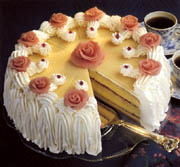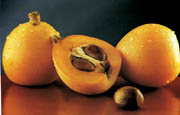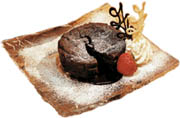
Every country, every culture in the world, shares a universal sweet tooth. In fact, some researchers state the preference for sweet-tasting and fatty foods has been “hard wired” into us through evolution. Additionally, we often develop, through learning, a desire for various levels of saltiness, tartness and bitterness. In some cases, decadent pastries or desserts combine a balance of all these tastes. Is it any wonder we all love them? And it is no wonder that even when dieting, we resist giving them up.
Global food giants like Nestlé (White Plains, N.Y.), ConAgra (Omaha, Neb.) and General Mills (Minneapolis) offer products that count on this built-in preference. The largest international restaurant chains from McDonald's (Oak Brook, Ill.) to Starbucks (Seattle) all count on delicious, sweet desserts to increase sales.
Michael J. Goldstein, vice president of R&D with Love and Quiches Desserts (Freeport, N.Y.), shares his views on developing trends in this area. “The low-carb fad will not last. It will be gone in three to five years,” predicts Goldstein. “MIT [Massachusetts Institute of Technology, Cambridge, Mass.] has just released a study showing that very low-carbohydrate diets cause negative changes in people's brain chemistry. The New York Times just ran a story on it. There are actually cases where it is causing reduced productivity in businesses, according to the Times.” However, Goldstein also notes that Love and Quiches has created two low-carb items that are selling very well. Both the low-carb New York Cheesecake and a low-carb Chocolate Peek-a-boo, which is a rich chocolate tart, have only 3g of net carbs per serving. Yet, their single greatest new product success is the new “Crunchy Fried Cheesecake,” an item that goes completely against the “diet-grain.”
Health and wellness is, of course, on the front page of many news stories as well as our customers' minds. But will tomorrow's pastry and dessert trends reflect this? Where do the latest cutting edge concepts and dessert “fashions” start? Most wise research chefs will agree that many long-term food trends, as apposed to fads, begin not as newspaper headlines but in high-end restaurants. From there, these new ideas make their way to fast casual, then to quick service restaurants (QSR) and, finally, onto supermarket shelves. Small upscale restaurants can afford to take risks and try truly new ideas, techniques and products. Chefs are face-to-face with the customers every night. That makes 365 customer focus panels a year!
It is that intimate contact with the consumer that gives fine dining chefs “the chef's edge” on what the latest developing trends are ... and will be. Here is a look at what one restaurant is offering.

Targeting Dessert Trends
Sugar is a dessert bar in Chicago's trendy River North neighborhood. One of the hottest nightspots in the city, this rising star is different from any other restaurant. The 12-page menu offers only super-decadent pastries, sweets and desserts! No entrées, no appetizers, no salads. Pastries and desserts are the star attraction, and are offered with high-quality champagne, wines and liquors Since its opening day, Sugar has had “standing room only” every night.Pastry chef Christine McCabe, Sugar's executive chef, shares some of her observations regarding current dessert trends and what she sees for the near future.
“Customers between 35 and 45 years old are becoming more adventurous about flavors,” she says. “Exotic fruits, and unusual spice/flavor combinations are working with this age group. Younger people, aged 20 to 30, are less open to really 'out there' flavors when it comes to desserts. Even though you might expect them to be more adventurous, with pastries and sweets, that's not the case.” For the 20-somethings, chocolate items outsell exotic fruit products four to one. It is the more experienced diners that are willing to experiment with edgy new combinations.
“Unusual combinations of familiar foods or unusual foods used in familiar recipes are what we have been adding to our menu,” says McCabe. “[For example,] yams from Africa or caramelized onion in a dessert, [or] green tea ice cream on a red pepper-dark chocolate base. By combining the commonplace with the exotic, the door is opened for customers to try exciting new flavors and textures. Fresh, ripe fruit is also a constant on the menu being used in many items: familiar fruits in unusual recipes or exotic fruits in familiar uses.”
Ed Sugi, Sugar's manager, shares his frustration with fad diets in general. “If I had one wish, it would be that customers would be more adventurous and open to exotic fruits or spices. Rather than searching for a magic way to eat huge amounts of snacks, eat small portions of luscious, rich dessert. Try every new exciting flavor there is!” Ed believes tiny amounts of super-rich foods satisfy more than piles of tasteless low-cal snacks or low-carb gimmicks.
The saying goes, “The proof is in the pudding.” Of course, manufacturing must stay in tune with customers' current desires. But smart marketers and product developers watch the winners. Sugar has been riding a double-digit increasing trend in sales since opening day and shows no sign of slowing down. And yet, it doesn't feature a single diet item on the menu.

Super Bowl of Creative Desserts
Much of our modern cuisine is only possible because of the “Kitchen Brigade” system created shortly following the French Revolution. This management reporting-tree is loosely based on the basic military command structure. Just as a general is the leader of all the forces under his management, so is the executive chef (chef is French for “chief”) the CEO of the kitchen. In this very specialized structure, the jobs of “bread baker” and “pastry chef” are separate and entirely different areas of expertise. This is because both require years of difficult training and experience. Both require a very deep knowledge of food science. Additionally and arguably, the pastry chef must be far more of an artist than the bread baker.Once every two years, dozens of the world's greatest pastry chefs—true world-class artists—come together to compete in the U.S. This “Super Bowl” of the pastry world is known as the World Pastry Team Championship. Held each year in Las Vegas, this year's event will take place on July 7th. Contestants from countries such as France, Italy, Japan, Korea and virtually every country compete to prove their worth. Last year, Patrice Caillot, Vincent Pilon and Claude Escamilla, of the U. S., won the Team Grand Prize. The event features some very impressive works of pastry art, and contests for the best chocolate sculptures, sugar show pieces and amazing tiny works of edible art.
This year's theme is the “Four Elements of Nature: Earth, Wind, Fire and Water.” Each of the elements must somehow be expressed by the contestants' pieces in order to win the judges' approval. Of course, each and every masterpiece of pastry art will have to be flawless.
Such lofty haute cuisine has little to do with the meals eaten each day by average consumers. However, it is from the white tablecloth restaurants that mainstream trends find their beginnings. Only a few years ago, a vegetarian entrée won the first gold medal ever for such an entry at a world culinary competition! This year, we may see a reduced-calorie or low-carb entry in the world pastry championships... we can only wait and see.
Interested in attending or working at the World Pastry Championship as a volunteer? Please contact Elena Clement to find out what positions are available, or to inform her of your availability. She can be reached at eclement@jwu.edu, or 303-256-9421. For more information, www.pastrychampionship.com.
Sidebar:
Plus: A Tip on Low-carb Sweeteners
Sweetness is the crucial element in desserts. What is one to do when sucrose and other traditional carbs are not to be used? Here's a list of a few to consider:
Xylitol: A monosaccharide polyol (a.k.a. sugar alcohol). It has the same sweetness, bulk and caloric value as sucrose. FDA allows the use of a caloric value of 2.4 calories per gram.
Sorbitol: A monosaccharide polyol approximately 0.5-0.7 times as sweet as sucrose. Excessive consumption (more than 50-80g/day) may have a laxative effect. FDA allows the use of a caloric value of 2.6 calories per gram.
Mannitol: A monosaccharide polyol. Approximately 0.7 times as sweet as sucrose. Used as a bulking agent in powdered foods. Excessive consumption (more than 20g/day) may have a laxative effect. FDA allows the use of a caloric value of 1.6 calories per gram.
Isomalt: A disaccharide polyol, about 45-65% as sweet as sucrose. FDA allows the use of a caloric value of 2.0 calories per gram.
Maltitol: A disaccharide polyol produced by the hydrogenation of maltose. Approximately 0.9 times as sweet as sucrose, with a similar sweetness and body. FDA allows the use of a caloric value of 2.1 calories per gram.
Lactitol: Sweet-tasting disaccharide polyol derived from lactose. Provides bulk and texture of sucrose with half the calories. It is some 30% to 40% as sweet as sucrose. FDA allows the use of a caloric value of 2.0 calories per gram.
Hydrogenated starch hydrolysates (HSH--a.k.a. maltitol syrup or hydrogenated glucose syrup): A mixture of sorbitol, maltitol and hydrogenated oligosaccharides.Depending on the type of HSH desired, the maltitol and sorbitol content can be varied. The sweetness of HSH, therefore, varies from 25% to 5% of that of sucrose. FDA allows the use of a caloric value of 3.0 calories per gram.
Erythritol: About 70% as sweet as sucrose. Some 7% to 13% the calories of other polyols, and 5% the calories of sucrose.